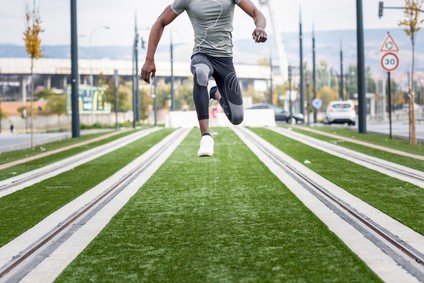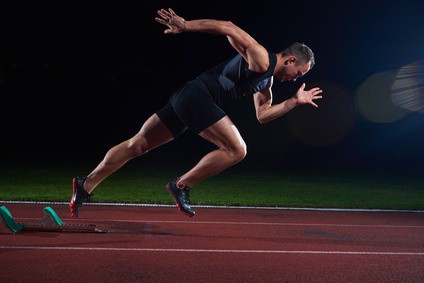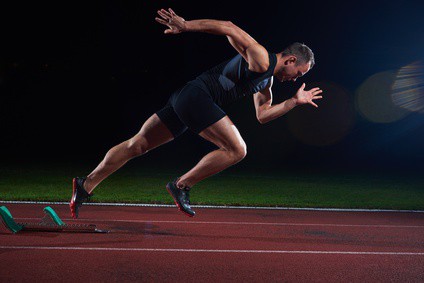One of the best jump coaches in the world is Nelio Moura, Brazilian national jumps coach, with multiple Olympic gold medalists to his name. I first heard of Nelio a decade ago through his great work on special strength training for jumpers which was my first exposure to ideas like deloading every third week, or assisted jump training for better reactivity. After trying the methods in the article in real life, I found amazing results, particularly in going from the typical 3 on, 1 easy cycle, to 2 on 1 easy in particular points of the season.
To that end, I was really excited to get Nelio Moura for a written question and answer segment for Just Fly Sports. In this Q&A, Nelio answers questions on:
- Overshoot and supercompensation in fast-twitch fibers and training implications
- Power to weight ratios for jumpers, and when is an athlete “strong enough”?
- Using VBT and ballistic work in the weightroom
- Using shorter training cycles for jumpers
- Plyometric progressions through the training season
What’s your approach to “overshoot” (super-compensation of fast-twitch IIB fibers after a period of detraining) in strength training and performance? How will your off-season and preparatory periods differ from in-season work in terms of volume and load in the weightroom?
Nelio Moura: The “overshoot” phenomenon opens avenues of possibilities regarding training planning, but so far it is not well understood. Original research showed three months of detraining after three months of heavy strength training could double the amount of the fastest IIx muscle fibers (Andersen, Schjerling, & Saltin, 2000).
This sounds good for jumpers, but those fast fibers are useless if they are weak… The task at hands of training methodologists is to find a way to explore the overshoot phenomenon in real life. Liu et al. (2003) showed that both resistance training and a combined program of resistance and plyometric training increase the amount of type IIa fibers after 6 weeks of training. The difference is that resistance training alone does it at expense of fibers IIx while, when combined with plyometric training, maintains the amount of IIx and decreases the proportion of fibers type I.

Barbell work combined with plyometric training, maintains the amount of IIx fibers and decrease the proportion of slow-twitch type I.
In my practice, I use blocks of 6 weeks of predominantly heavy resistance training during preparatory periods, followed by 6 weeks of explosive resistance training and plyometric training. During the competitive season that follows, I decrease frequency and volume of resistance training sessions (but including very short maximal strength sessions), and rely mostly on plyometric training to maintain or further develop the level of specific strength. I hope that with this design, after tapering for the most important competitions, the overshoot can be present.
In terms of power to weight ratios for jumpers, at what point is an athlete “strong enough” for their event? Do you push to achieve any particular 1 rep-max number in the weightroom for these athletes?
Nelio Moura: Our ultimate goal is to prepare the athlete to be able to exert the highest possible forces in less than 150ms. In novices, maximal strength is highly related to this reactive strength, so it makes sense training with the aim of improve it. However, there is no relationship between these two manifestations in highly trained athletes. Considering this, I do not set any goal for 1 RM. I assume most of them are already “strong enough”.

“Our ultimate goal is to prepare the athlete to be able to exert the highest possible forces in less than 150ms.”
Do you use ballistic and velocity based work in the weightroom, where measuring bar speed is a priority? Do you utilize overloaded eccentric training for jumpers in the weightroom?
Yes, but mostly for testing. It helps me to individualize the loads without the need to test for 1 RM. There is plenty of commercially available equipment to do so, and I use MuscleLab. I also use overloaded eccentric training for tendon (patellar and Achilles) and hamstring prophylaxis.
You’ve mentioned your use of shorter training cycles for your jumpers, such as 2-weeks on, and 1-week off? Do you use longer cycles in preparation, and at what point do you begin to utilize shorter cycles? Do you ever use 1-week on and 1-week easy cycles?
Nelio Moura: I begin the preparation with a 4-week General Preparatory Period, where the load dynamics is 3:1. Then during the Special Physical Preparation and the Technical Blocks, the dynamics changes to 2:1. During Pre-competition and Competition phases, it is 1:1.
But this is all planning, usually what happens in real life is different. I monitor training load with the Session-RPE method, and use a Wellness questionnaire to check if the athletes are ready for training, on a daily basis. A computer system (AthleteMonitoring) helps me to interpret the data. I pay special attention to the week-to-week load increase (or decrease), and to the acute:chronic load ratio (Gabbett, 2016).
What is your approach to plyometric progressions throughout the course of a training season?
Nelio Moura: Plyometrics is a world apart, there are so many possibilities… in order to organize the gradual progression of plyometric training, I use a few “rules”, that apply considering both the long term athlete development and the single season:
- Surface (sand –> mini-tramp –> grass –> competition surface).
- Support time (longer –> shorter –> shortest).
- Footwear (bare feet –> training shoes –> competition shoes).
- Support (double leg –> single leg).
- Direction (vertical –> horizontal).
- Intensity (low –> moderate –> high).
- Specificity (general –> special –> specific).
- Volume (high –> low).
- Drop height (below the optimal height –> equal the optimal height –> above the optimal height, in very specific cases).
In short, I expect plyometric training “develop” itself throughout the athlete’s career, (or season), reaching the maturity, with highly specific and intense exercises (single leg supports, horizontal, similar to the competitive task, performed on the track with spike shoes), at the Special Preparation or Pre-competition phases of experienced athletes. During these phases, I also use vertical jumps assisted by elastic cords (to artificially reduce the body weight). These jumps allow (and demand) high levels of reactivity.

